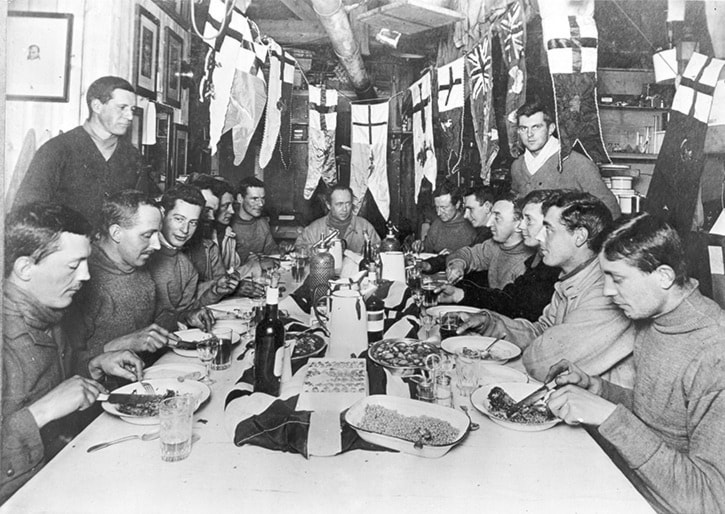In the race to the South Pole a century ago, the British and Norwegian explorers hunkered down for the long, dark Antarctic winter in their huts and underground caves. It would be nearly a year before the teams made their dash to the bottom of the world.
In terms of food, fuel, clothing, shelter and animals, the teams had what they had – if things went wrong, there was no communication with the outside world, no escape from the pack ice and no rescue.
This story of the first men to reach the South Pole – a national triumph for Norway’s Roald Amundsen and a profound tragedy for Britain’s Robert Falcon Scott – is opening as a major exhibition at the Royal B.C. Museum next Friday.
“It’s one of the greatest, if not the greatest story of exploration,” said Tim Willis, vice-president, visitor engagement and experience with the RBCM. “The story is a study in contrasts. Amundsen is a professional explorer who learned from the Inuit, who has spent his whole life from childhood developing the skills for polar exploration.
“Scott was a navy officer with ambition to make his mark ... he is leading an expedition of exploration on a wide scale – the geographical, the geophysical, he studied weather and polar conditions with an eye on the pole. The exhibit tries to take you through that journey and give people a sense of what they endured.”
The Race to the End of the Earth is the only stop in Canada, and is displayed in partnership with the American Museum of Natural History in New York.
The exhibit leads visitors through the history of Antarctic exploration, the colourful personalities of Scott and Amundsen, and their men, and the story of the ingenuity, endurance and suffering of those who pushed through blizzards, mountains and ice fields to reach an unremarkable location at zero degrees latitude south.
“The race to get to the pole was an enormous journey of 1,800 miles in two stages, across the Ross ice shelf ... and across the polar plateau of 9,000 or 10,000 feet high,” Willis said. “It was a gruelling physical challenge in terrible conditions. They went at the best time from a weather point of view, but it was still bad with blizzards and wind and hugely sub-zero.”
The exhibit gives a sense of the living conditions with a replica of Scott’s hut (still preserved in Antarctica today) and a replica of Amundsen’s underground ice caves, which among other amenities, included a sauna room.
The centre of the exhibit is an ominous black tent imported from Norway, the same that Amundsen left at the South Pole and which marked Scott’s worse fear – arriving second.
Amundsen’s original sledge and binoculars for his South Pole push will be on display, among other personal items, such as letters written by Scott and his team in their dying days during their return trek from the pole.
Scott’s final camp was found eight months after he and his team froze to death.
“Chances of finding his tent were slight, but it was found, and with all the photographs and personal records. They wrote until they died,” Willis said. “In a way this is a story told by the people there, what they went through. It makes it so compelling.
“Whoever reads (Scott’s) letters can’t help but be hugely moved by his courage. What they had to endure is beyond imagining ... he had no help, poor equipment and did it with a lot of grace.”
Scott was stationed in Victoria for a time in 1889 as a lieutenant in the British Royal Navy.
For his 1911-12 Terra Nova expedition, Scott hired on Canadian scientist Charles Wright, who later worked at the naval laboratory in Esquimalt and at Royal Roads, and also adventurer and naval officer Cecil Meares as the dog handler. The RBCM has Meares’ original pennant used on a sledge.
Meares settled in Oak Bay in the 1920s after a remarkable life as a fur trader (and possibly a British spy) in Russia and Manchuria, and as an officer who fought in the Boer War and the First World War. He even helped train Japanese pilots in 1921 as part of a British military advisory mission.
“He advised the Japanese Imperial Navy on torpedo bombing,” Willis remarked. “Meares had an astonishing life and then quietly retired to Oak Bay. We’ve got his sledging pennant. It’s one of the few that survive.”
Race to the End of the Earth opens at the RBCM opens May 17. See explore.royalbcmuseum.bc.ca.
editor@saanichnews.com
Race to the RBCM
RBCM is hosting a number of events linked to the Race to the End of the Earth exhibit.
-Ross MacPhee, curator from the American Museum of Natural History (and former UVic professor) gives a talk on the Scott-Amundsen race on May 16, 7:30 p.m. Tickets $30.
-The RBCM hosts lectures from Antarctic explorers July 4, 18, Aug. 1, Sept. 5 and Oct. 3. See explore.royalbcmuseum.bc.ca.
 Sharon Tiffin/News staff
Sharon Tiffin/News staff
Kate Kerr, Royal B.C. Museum exhibit art technician, works on putting together Captain Robert Falcon Scott’s hut as the museum prepares its new exhibit, Race to the End of the Earth.
